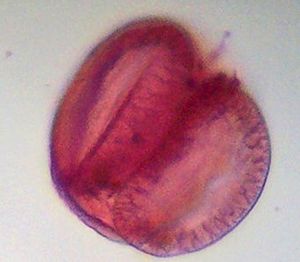Archaeological palynology (Biology)
Contents
Archaeological palynology
Archaeological palynology is characterized by the analysis of artifacts, features, and coprolites from archaeological sites as well as stratigraphic study of its sediments. Archaeological palynology in North America was heavily influenced by Paul Martin and his colleagues during the 1950's and 1960's. Although his interests primarily were in the effects of prehistoric climate change on the North American megafauna, his connection with the Geochronology Laboratory of the University of Arizona led to the pollen analysis of many archaeological sites in the American Southwest. The aridity of the Southwest USA produces excellent pollen preservation in open archaeological sites and in alluvial settings. Martin recognized the power of archaeological palynology to trace the history of the domestication and cultivation of plants.
Artifact Sourcing
Martin and his students (Bohrer, Hevly) also pioneered the pollen analysis of archaeological artifacts with the "pollen wash" of ground-stone artifacts. This technique is frequently applied, but has never been rigorously investigated. It consists of analyzing the pollen from material imbeded in an artifact.
Human Coprolites
The superb preservation provided by southwestern aridity has allowed the detailed analysis of human dietary preferences.
History of Plant Domestication
Paul Martin and his students were the first to apply palynology to the study of plant domestication in North America. Corn (Zea mays) is the most commonly found pollen of a cultigen. Squash and cotton (but not bean) also occur, as do “incipient cultigens“ such as Agave, Cleome, Opuntia, other cacti and the abundant pollen of various "weeds." The foods and fibers upon which civilization is based were first selected and cultivated by humans in the early Holocene. Early examples are wheat in the Near East and squash in Central America. Cotton remains an abominable mystery, its domestication having occurred separately in Egypt and Arizona.
Further Reading
- Adams, Karen R., 1988. The ethnobotany and phenology of plants in and adjacent to two riparian habitats in southeastern Arizona. Ph.D. dissertation, Univ. Arizona.
- Alwynne Beaudoin's Dung Bibliography
- Bohrer, Vorsilla L., 1968. Paleoecology of an archaeological site near Snow Flake, Arizona. Ph.D. dissertation, Univ. Arizona.
- Bryant, Jr., Vaughn M. and R G. Hollloway, 1983. The role of palynology in archaeology. Advances in Archaeology Method and Theory. 6:191-224.
- Gish, Jannifer W., 1994. Large fraction pollen scanning and its application to archaeology. pp. 93-100 In: Davis, O. K. Aspects of archaeological palynology: methodology and applications. AASP Contributions Series 29.
- Hevly, Dick H., 1964. Pollen analysis of Quaternary archaeological and lacustrine sediments from the Colorado Plateau. Ph.D. dissertation, Univ. Arizona.
- Kelso, Gerald K., 1971. Hogup Cave, Utah: Comparative pollen analysis of human coprolites and cave fill. Ph.D. dissertation, University of Arizona.
- Martin, Paul S., 1963. The last 10,000 years. Univ. Arizona Press.
- Martin, Paul S. and Jim Schoenwetter, 1960. America's oldest cornfield. Science 132: 33-34.
- Martin, Paul S. and Floyd W. Sharrock, 1964. Pollen analysis of prehistoric human feces: a new approach to ethnobotany. American Antiquity 30:168-180.
- Schoenwetter, James, 1974. American Antiquity 39:292-303.
- Smith, Bruce D., 1997. The initial domestication of Cucurbita pepo in the Americas 10,000 years ago. Science 276:932-934.
- Sobolik, Kristin D., 1988. The importance of pollen concentration values from coprolites: an analysis of southwest Texas samples. Palynology 12:201-214.
- Wright, Jr., Herb E., 1977. Environmental change and the origin of agriculture in the old and new worlds. pp. 281-318 In: C.A. Reed (ed.) Origins of Agriculture, The Hague, Mouton Publ. (Arendt, 2004)
